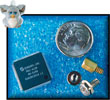

There is a new wave of interactive toys ready to explode on the marketplace. If it talks, hears and 'understands' you, it is probably using an integrated circuit developed by Sensory, a Silicon Valley-based company with over 10 years experience in designing low-cost speech technologies into consumer electronics.
Featuring highly accurate voice recognition, speech synthesis and command and control capability, Sensory says that its RSC-4128 IC is being used as the main brain unit for a new generation of low-priced interactive consumer products. For example, Hasbro's Tiger Electronics division has developed an all-new Furby toy that has been engineered with Sensory's RSC-4128 microcontroller providing the brains necessary for its many advanced new functions.
Single processor for advanced functions
The new Furby is larger and uses six times more memory than its predecessor, allowing for complex motor controls (dancing, expressive eyes and moving ears), multiple sensors (tilt, tickling, petting and feeding), and advanced multilingual speech capabilities (talking and hearing). Most importantly, adds Sensory, all of its 'brains' are located on a single chip, which keeps the cost of a new Furby under approximately US$40 at retail.
Using a technology designed by Hasbro called 'Emoto-Tronics', the evolved Furby creature displays many new personality characteristics that will make it more life-like. "Because of advances in technology, we have been able to make the new Furby with many of the features that we had wanted to put in the original but could not because of cost," said Leif Askeland, vice president of engineering and technology development for Hasbro. "Thanks to Sensory's cutting-edge ICs and speech technologies, the new Furby creature can actually listen to what you say and respond in a very vibrant fashion. It 'understands' requests to sing a favourite song, tell jokes, dance and play interactive games. It can also communicate with children and other Furby creatures using human languages, as well as its native 'Furbish,' making it a uniquely multilingual."
Speech capabilities
The toy's speech capabilities were developed using Sensory's Quick Text to Speaker Independent (Quick T2SI) recognition technology, which allows vocabularies in multiple languages to be built for an RSC-4128-enabled product using text models that can be fine-tuned for a particular dialect. According to Sensory, the command words are referred to as speaker independent - they work with any speaker (male, female, child or adult) in a given language, and they even recognise different accents, such as the difference between American and British English.
| Tel: | +27 11 854 5011 |
| Email: | [email protected] |
| www: | www.khd.co.za |
| Articles: | More information and articles about KH Distributors |

© Technews Publishing (Pty) Ltd | All Rights Reserved